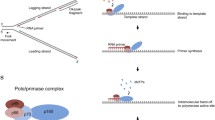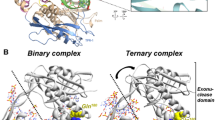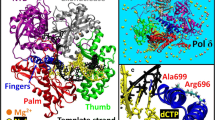Abstract
The role of the 5′ terminal phosphate group downstream from the primer and magnesium cations in the energetics and dynamics of the gapped DNA recognition by rat polymerase β have been examined, using the fluorescence titration and stopped-flow techniques. The analyses have been performed with the entire series of gapped DNA substrates differing in the size of the ssDNA gap. The 5′ terminal phosphate group and magnesium cations exert antagonistic effect on enzyme binding to gapped DNA that depends on the length of the ssDNA gap. The PO −4 group amplifies the differences between the substrates with different ssDNA gaps, while in the presence of magnesium, affinities and structural changes induced in the DNA are very similar among examined DNA substrates. Both, the phosphate group and Mg+2 differ dramatically in affecting the thermodynamic response of the gapped DNA-rat pol β system to the salt concentration. The data indicate that these distinct effects result from affecting the structure of the DNA, in the case of the phosphate group, and from direct magnesium binding to the protein. The mechanism of rat enzyme binding depends on the length of the ssDNA gap and the presence of the 5′ terminal phosphate group. Complex formation with DNAs having three, four, and five residues in the gap occurs by a minimum three-step sequential mechanism. Depending on the presence of the 5′ terminal phosphate group and/or magnesium, binding of the enzyme to a DNA containing two residues in the ssDNA gap is described by the same three-step or by a simpler two-step mechanism. With the DNA containing only one residue in the gap, binding is always described by only a two-step mechanism. The PO −4 group and magnesium cations have opposite effects on internal stability of the complexes with different length of the ssDNA gap. While the PO −4 group increases the stability of internal intermediates with the increasing length of the gap, Mg+2 decreases the stability of the intermediates with longer ssDNA gap. As a result, the combined favorable orientation effect of the phosphate group and the unfavorable Mg+2 effect lead to the optimal docking of the ssDNA gaps with three and four residues by the enzyme.
Similar content being viewed by others
References
Friedberg, E.C., Walker, G.C. and Siede, W. DNA Repair and Mutagenesis. ASM Press, Washington DC, 1995.
Budd, M. E. and Campbell, J. L. (1997) The roles of the eucaryotic DNA polymerases in DNA repair synthesis. Mutation Res. 384, 157–167.
Fry, M. and Loeb, L. A., Animal Cell DNA Polymerases. CRC Press, Boca Raton, FL, 1986.
Johnson, R. E., Prakash, S. and Prakash, L. (1999) Efficient bypass of a thymine-thyminedimer by yeast DNA polymerase, Pol η. Science 283, 1001–1004.
Hubscher, U., Nasheuer, H.-P. and Syvaoja, J. E. (2000) Eukaryotic DNA polymerases, a growing family. Trends Biochem. Sci. 25, 143–147.
Sobol, R.W., Horton, J.K., Kühn, R., Hua, G., Singhal, R.K., Prasad, R., et al. (1996) Requirement of mammalian DNA polymerase β in base-excision repair. Nature 379, 183–186.
Wiebauer, K. and Jiricny, J. (1990) Mismatchspecific thymine DNA glycosylase and DNA polymerase β mediate the correction of G-T mispairs in nuclear extracts from human cells. Proc. Natl. Acad. Sci. USA 87, 5842–5845.
Matsumoto, Y. and Bogenhagen, D. F. (1989) Repair of synthetic abasic site inDNA in aXenopus laevis oocyte extract. Mol. Cell. Biol. 9, 3750–3757.
Matsumoto, Y. and Bogenhagen, D. F. (1991) Repair of a synthetic abasic site involves concerted reactions of DNA synthesis followed by excision and ligation. Mol. Cell Biol. 11, 4441–4447.
Matsumoto, Y., Kim, K. and Bogenhagen, D. F. (1994) Proliferating cell nuclear antigen-dependent abasic site repair in Xenopus laevis oocytes: an alternative pathway of base excision dna repair. Mol. Cell. Biol. 14, 6187–6197.
Prasad, R., Beard, W. A. and Wilson, S. H. (1994) Studies of gapped DNA substrate binding by mammalian dna polymerase β. J. Biol. Chem. 29 18096–18101.
Hammond, R. A., McClung, J. K. and Miller, M. R. (1990) Effect of DNA polymerase inhibitors on DNA repair in intact and permeable human fibroblasts: evidence that DNA polymerases δ and β are involved in DNA repair synthesis induced by N-methyl-N′-nitro-N-nitrosoguanidine. Biochemistry 29, 286–291.
Hoffman, J. S., Pillaire, M. J., Maga, G., Podust, V., Hubscher, U. and Villani, G. (1995) DNA polymerase β bypasses in vitro a single d(GpG)-cisplatin adduct placed on codon 13 of the HRAS gene. Proc. Natl. Acad. Sci. USA 92, 5356–5360.
Masumoto, Y., and Kim, K. (1995) Excision of deoxyribose phosphate residues by DNA polymerase β during DNA repair. Science 269, 699–702.
Pelletier, H., Sawaya, M. R., Kumar, A., Wilson, S. H. and Kraut, J. (1994) Structures ofternary complexes of rat DNA polymerase β, a DNA template-primer, and ddCTP. Science 264, 1891–1903.
Pelletier, H., Sawaya, M. R., Wolfle, W., Wilson, S. H. and Kraut, J. (1996) A structural basis for metal ion mutagenicity and nucleotide selectivity in human DNA polymerase β. Biochemistry 35, 12762–12777.
Sawaya, M. R., Pelletier, H., Kumar, A., Wilson, S. H. and Kraut, J. (1994) Crystal structure of rat DNA polymerase β: Evidence of a common polymerase mechanism. Science 264, 1930–1935.
Joyce, C. M. and Steitz, T. A. (1994) Function and structure relationships in DNA polymerases. Annu. Rev. Biochem. 63, 777–822.
Rajendran, S., Jezewska, M. J. and Bujalowski, W. (1998) Human DNA polymerase β recognizes single-stranded DNA using two different binding modes. J. Biol. Chem. 273, 31021–31031.
Jezewska, M. J., Rajendran, S. and Bujalowski, W. (1998) Transition between different binding modes in rat DNA polymerase β-ssDNA complexes. J. Mol. Biol. 284, 1113–1131.
Jezewska, M. J., Rajendran, S. and Bujalowski, W. (2001) Interactions of the 8-kDa domain of rat DNA polymerase β with DNA. Biochemistry 40, 3295–3307.
Jezewska, M. J., Rajendran, S. and Bujalowski, W. (2001) Energetics and specificity of rat DNA polymerase β interactions with template-primer and gapped DNA substrates. J. Biol. Chem. 276, 16123–16136.
Rajendran, S., Jezewska, M.J. and Bujalowski, W. (2001) Recognition of template primer and gapped DNA substrates by human DNA polymerase β. J. Mol. Biol. 308, 477–500.
Jezewska, M. J., Galletto, R. and Bujalowski, W. (2002) Dynamics of gapped DNA recognition by human polymerase β. J. Biol. Chem. 277, 20316–20327.
Jezewska, M. J., Rajendran, S., Galletto, R. and Bujalowski, W. (2001) Kinetic mechanisms of rat polymerase β-ssDNA interactions. Quantitative fluorescence stopped-flow analysis of the formation of the (Pol β)16 and (Pol β)5 binding mode. J. Mol. Biol. 313, 977–1002.
Edelhoch, H. (1967) Spectroscopic determination of tryptophan and tyrosine in proteins. Biochemistry 6, 1948–1954.
Gill, S. C. and von Hippel, P. H. (1989) Calculation of protein extinction coefficients from amino acid sequence data. Anal. Biochem. 182, 319–326.
Bujalowski, W., Klonowska, M. M. and Jezewska, M. J. (1994) Oligomeric structure of Escherichia coli primary replicative helicase DnaB protein. J. Biol. Chem. 269, 1–9.
Galletto, R., Rajendran, S., and Bujalowski, W. (2000) Interactions of nucleotide cofactors with the Escherichia coli replication factor DnaC protein. Biochemistry 39, 12959–12969.
Bujalowski, W. and Jezewska, M. J. (1995) Interactions of Escherichia coli primary replicative helicase DnaB protein with single-stranded DNA. The nucleic acid does not wrap around the protein hexamer. Biochemistry 34, 8513–8519.
Jezewska, M. J. and Bujalowski, W. (1996) Global conformational transitions in E. coli primary replicative DnaB protein induced by ATP, ADP and single-stranded DNA binding. J. Biol. Chem. 271, 4261–4265.
Jezewska, M. J., Rajendran, S., Bujalowska, D. and Bujalowski, W. (1998) Does ssDNA pass through the inner channel of the protein hexamer in the complex with the E. coli dnaB helicase? Fluorescence energy transfer studies. J. Biol. Chem. 273, 10515–10529.
Jezewska, M. J., Rajendran, S. and Bujalowski, W. (1998) Functional and structural heterogeneity of the DNA binding of the E. coli primary replicative helicase DnaB protein. J. Biol. Chem. 273, 9058–9069.
Jezewska, M. J., Rajendran, S. and Bujalowski, W. (1997) Complex of Escherichia coli primary replicative helicase DnaB protein with a replication fork. Recognition and structure. Biochemistry 37, 3116–3136.
Bujalowski, W. and Jezewska, M. J. Spectrophotometry & Spectrofluorimetry. A Practical Approach. (Gore, M. G., ed.) Oxford University Press, London, 2000.
Bujalowski, W. and Jezewska, M. J. (2000) Kinetic mechanism of the single-stranded DNA recognition by Escherichia coli replicative helicase DnaB protein. Application of the matrix projection operator technique to analyze stopped-flow kinetics. J. Mol. Biol. 295, 831–852.
Bujalowski, W. and Jezewska, M. J. (2000) Kinetic mechanism of nucleotide cofactor binding to Escherichia coli replicative helicase DnaB protein. Stopped-flow kinetic studies using fluorescent ribose-, and base-modified nucleotide analogs. Biochemistry 39, 2106–2122.
Rajendran, S., Jezewska, M. J., and Bujalowski, W. (2000) Multiple-step kinetic mechanism of DNA-independent ATP binding and hydrolysis by Escherichia coli replicative helicase DnaB protein: Quantitative analysis using the rapid quench-flow method. J. Mol. Biol. 303, 773–795.
Pilar, R. L. (1968) Elementary Quantum Chemistry. New York: McGraw-Hill.
Record, M. T., Lohman, T. M., and deHaseth, P. L. (1976) Ion effects on ligand-nucleic acid interactions. J. Mol. Biol. 107, 145–158.
Record, M. T., Jr., Anderson, C. F., and Lohman, T. M. (1978) Thermodynamic analysis of ion effects on the binding and conformational equilibria of proteins and nucleic acids: the roles of ion association or release, screening, and ion effects on water activity. Q. Rev. Biophys. 11, 103–178.
Von Hippel, P. H. and Schleich, T. Structure of Biological Macromolecules. Timasheff, S. and Fasman G. D. Eds. New York: M. Dekker, New York, 1969.
Bernasconi, C.J. Relaxation Kinetics. Academic Press, NY, 1976.
Bujalowski, W., Greaser, E., McLaughlin, L.W. and Porschke, D. (1986) Anticodon loop of tRNAPhe: structure, dynamics and Mg+2 binding. Biochemistry 25, 6365–6371.
Bujalowski, W., Jung, M., McLaughlin, L. W. and Porschke, D. (1986) Codon-induced association of the isolated anticodon loop of tRNAPhe. Biochemistry 25, 6372–6378.
Jezewska, M. J., Galletto, R. and Bujalowski, W. (2001) Multiple-step kinetic mechanisms of the ssDNA recognition process by human polymerase β in its different binding modes. Biochemistry 40, 11794–11810.
Connors, K.W. Chemical Kinetics. The Study of Reaction Rates in Solution VCH, New York, 1990, pp. 133–186.
Berry, R.S., Rice, S.A. and Ross, J. Physical Chemistry. New York: Wiley, New York, 1980, pp. 1117–1204.
Porschke, D. (1976) The nature of stacking interactions in polynucleotides. Molecular states in oligo-polribocytidylic acids by relaxation analysis. Biochemistry 15, 1495–1499.
Porschke, D. (1978) Molecular states in singlestranded adenylate chains by relaxation analysis, Biopolymers 17, 315–232.
Zhong, X., Patel, S. S., Werneburg, B. G. and Tsai, M-D. (1997) DNA polymerase β: conformational changes in the mechanism of catalysis. Biochemistry 36, 11891–11900.
Author information
Authors and Affiliations
Corresponding author
Additional information
This work was supported by NIH Grant GM-58565 (to W. B.)
Rights and permissions
About this article
Cite this article
Jezewska, M.J., Galletto, R. & Bujalowski, W. Rat polymerase β gapped DNA interactions. Cell Biochem Biophys 38, 125–160 (2003). https://doi.org/10.1385/CBB:38:2:125
Issue Date:
DOI: https://doi.org/10.1385/CBB:38:2:125




